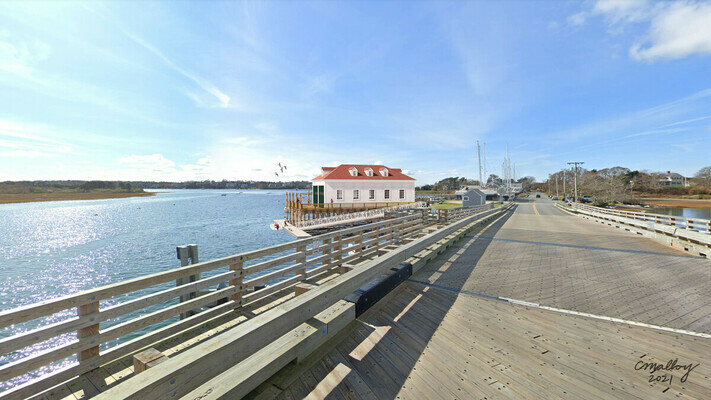90 Bridge St. Project To Cost $11M; Select Board Says Waterfront Job Will Be Worthwhile
 A rendition of the completed project at 90 Bridge St., showing the restored Coast Guard boathouse on its new pier near the Mitchell River drawbridge.
A rendition of the completed project at 90 Bridge St., showing the restored Coast Guard boathouse on its new pier near the Mitchell River drawbridge.
CHATHAM – In the works since 2016, the plan to build a new shellfish upweller and mixed-use pier at 90 Bridge St. is now at the 90 percent design phase, town staff told the select board last week. Together with the plan to reuse the historic Coast Guard boathouse, the $11.1 million project is expected to have significant economic and cultural benefits.
“I think the design of the project is really cool, and I think it’s going to be a great project,” select board member Jeffrey Dykens said. “It is an expensive one.”
Natural Resources Director Greg Berman updated the select board on the project last week. The work calls for the construction of a pier next to the Mitchell River drawbridge, which will house the historic boathouse that once sat on the shore of Stage Island, across the harbor. The repurposed structure, which is being gifted to the town, will provide a home for a new shellfish hatchery, replacing the current upweller at Old Mill Boatyard. The public will be able to learn about shellfish propagation and see the operation, and surrounding the pier will be floats available for recreational boaters to use. The small existing commercial pier will be extended slightly and will include a float for limited commercial offloading operations. The site will include around a dozen parking spaces and a restroom.
The project has evolved significantly since it was first conceived around 2016, Berman said. Just over $2 million was set aside in a waterfront bond authorization, which did not account for the cost of acquiring the property and conducting a feasibility study. “There really was no design at that point,” he said. A conceptual design in 2018 included a cost estimate of $4,975,000, but the design was further refined to include the Coast Guard boathouse and a reconfigured pier system, bringing the cost projection to $6,478,000 in 2021, when the design was 35 percent complete.
Now, with the design at 90 percent, the projected cost has jumped to $11,140,535, having “pretty much doubled” since the previous design, Berman said. “It’s not just our project. Projects all around the Cape and around Massachusetts have increased significantly during this time,” he said. The projected cost of the upweller pier jumped by about $1 million, the floating upweller system doubled in price, and the dredging estimate went from $90,000 in 2021 to $646,735. Cost estimates will continue to be refined and will only become firm once the project goes to bid.
Of the $11.1 million estimate, the town would be responsible for about $8.8 million, with the remainder coming from grants and other outside sources. Much of the funding has already come from a 2017 waterfront bond authorization, but voters at this year’s town meeting will be asked to authorize a second bond for a host of waterways projects. Of this $11.4 million authorization, about $2.3 million will need to be reserved for the 90 Bridge St. project.
Coastal Resources Director Ted Keon said staff also plan to apply for a Seaport Economic Council grant in the fall, and will keep looking for other grant opportunities.
“There are still some more rocks to turn over, and we will continue to do that,” he said.
“Knock on every door,” select board member Cory Metters said.
Town meeting will also be asked this year to appropriate $350,000 in Community Preservation Act funds to help with the historic restoration of the boathouse; another $350,000 in CPA money was approved for the purpose last year. The town’s waterways user fee revolving fund is expected to contribute $1.6 million to the project over two years.
“It’s no surprise that these costs have gone up over the last seven years or so,” Dykens said. He said he supports design changes that keep the project’s focus on a wide variety of public uses, rather than predominantly on the commercial fishery.
“I think there’s a value here that’s outstanding,” board member Shareen Davis said. Both for its shellfish propagation value and for educational purposes, the upweller should help the project stand out in grant applications. “We have the highest landing wild shellfishery in the state of Massachusetts when it comes to quahogs,” she said.
“I think it will be a real improvement of the look of that area as well,” board Chair Michael Schell said. Before town meeting, it will be useful to demonstrate to voters “what the potential economic returns of this project might be,” he said. Dykens said it should be fairly straightforward to show the economic value of the shellfishery which will be supported by the upweller.
“The return is ultimately quantifiable,” he said.
“But you also have to take into consideration the economic value of the other commercial activity and the recreational activity,” Davis said.
There will also be benefits that are not so easily measured, Berman said.
“A lot of it is going to be the qualitative — quality of life, access to water — that’s hard to put numbers on,” he said.
Keon said it’s important not to forget the historic preservation aspect of the project, saying there’s “a lot of interest and satisfaction that we’re actually going to potentially return the boathouse to its home.”
Please support The Cape Cod Chronicle by subscribing today!
You may also like:





